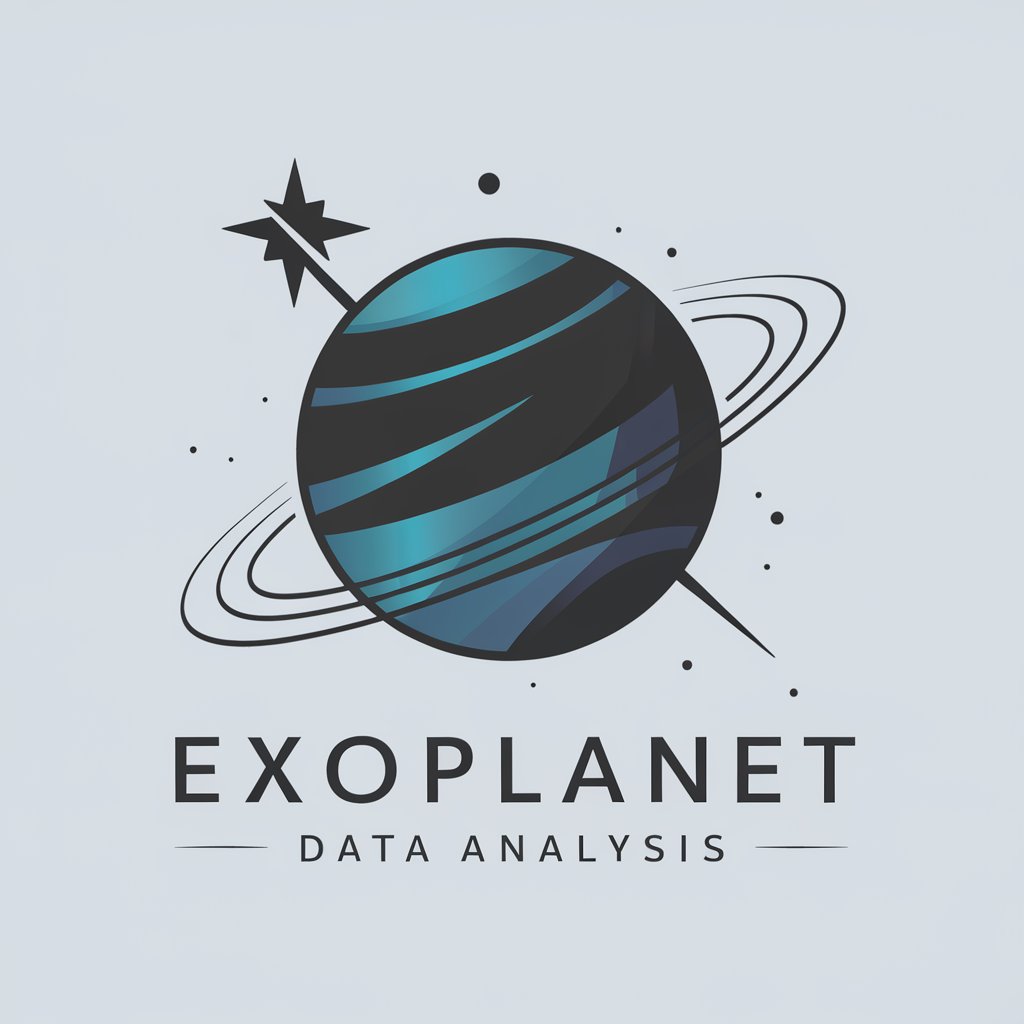Exoplanet Data Analysis - Exoplanet Data Insight

Welcome to Exoplanet Data Analysis, your AI assistant for exploring distant worlds.
Unveiling the Cosmos with AI
Analyze the atmospheric composition of...
Compare the habitability potential of...
Provide insights on the climate patterns of...
Suggest potential exoplanets for further observation based on...
Get Embed Code
Overview of Exoplanet Data Analysis
Exoplanet Data Analysis is specialized in processing and interpreting data related to exoplanets, particularly focusing on their atmospheres, compositions, and potential habitability. This GPT is designed to assist researchers by analyzing available exoplanetary data, identifying significant patterns, and suggesting hypotheses for further investigation. For example, it can analyze spectral data to infer the composition of an exoplanet's atmosphere or use transit photometry data to estimate an exoplanet's size and orbital characteristics. Powered by ChatGPT-4o。

Core Functions of Exoplanet Data Analysis
Atmospheric Analysis
Example
Analyzing the absorption features in the spectrum of an exoplanet to determine the presence of gases like water vapor, methane, or carbon dioxide.
Scenario
When observing the transit of exoplanet K2-18b, researchers can use this function to assess if its atmosphere contains water vapor, suggesting potential habitability.
Composition Estimation
Example
Using mass and radius data to calculate the bulk density of exoplanets, helping to differentiate between gaseous giants and terrestrial planets.
Scenario
For a newly discovered exoplanet with known mass and radius, this function helps in determining whether the planet is rocky like Earth or more like a mini-Neptune.
Habitability Assessment
Example
Evaluating the stellar flux, planet's orbital distance, and atmospheric conditions to assess if a planet falls within the habitable zone of its star.
Scenario
Applying this to TRAPPIST-1e to analyze its potential to support liquid water and, by extension, life, based on its position relative to its star.
Target User Groups for Exoplanet Data Analysis
Academic Researchers
Scientists and students in planetary science and astrophysics, needing detailed analysis for their research papers or projects, would find this GPT invaluable for interpreting complex exoplanetary data.
Space Agencies
Organizations like NASA or ESA could utilize this tool to sift through vast amounts of observation data to prioritize targets for future missions or deeper studies.
Science Educators
Educators looking to provide students with up-to-date, data-driven insights into exoplanetary science could use this tool to create engaging and informative content.

How to Use Exoplanet Data Analysis
1
Access a free trial at yeschat.ai, which requires no login and does not necessitate a ChatGPT Plus subscription.
2
Familiarize yourself with available datasets on exoplanets by exploring the database options provided under the resource section. This will help in understanding the variables and parameters you can analyze.
3
Utilize the query tool to select specific data sets or exoplanets. You can filter data based on characteristics such as planet size, distance from its star, or atmospheric composition.
4
Analyze the data using built-in tools for plotting trends, comparing planetary attributes, or estimating habitability based on known scientific models.
5
Generate reports or export data for further analysis in other software, making sure to interpret the results in the context of current astronomical theories and findings.
Try other advanced and practical GPTs
Compositional Layout Wizard
AI-driven iOS Layout Optimization

Raving Fans Gladiators
Elevating Customer Service into an Art

科研论文撰写者
Empowering Research with AI

Thalassarion and Aurorion Isles
Dive into Myth, Master Your Destiny

Golf Braking Master
Master Your Golf Braking with AI

SeasonAlly
Harness AI for Seasonal Choices

Chord Progression Matchmaker
Craft Your Feelings into Music

St. Clement of Alexandria
Illuminating the path of faith with reason

PDF Reconciler
Automate Financial Reconciliation with AI

Bank Reconciler
Simplify finance with AI-driven reconciliation.

Reconciliation Pro 2.0
Automate Your Numbers with AI

Fetch
Revolutionizing Chat History Search with AI

Frequently Asked Questions About Exoplanet Data Analysis
What types of data can I analyze with this tool?
The Exoplanet Data Analysis tool allows you to explore various data types such as planetary mass, orbital characteristics, atmospheric composition, and potential habitability based on the exoplanet's distance from its star and its host star's type.
How can this tool help in academic research?
This tool provides a comprehensive dataset and analytical tools that can support hypotheses testing, trend identification, and statistical analysis in fields related to astronomy and planetary science, enhancing the quality and efficiency of academic research.
Can I use this tool to compare different exoplanets?
Yes, the tool includes functionalities for comparing multiple exoplanets based on their physical and chemical properties, which can be useful for identifying patterns or anomalies among classes of exoplanets.
Is this tool suitable for beginners in astronomy?
While the tool is advanced, it is designed with an intuitive interface that allows individuals at all levels of expertise to navigate and utilize the data effectively, provided they have a basic understanding of the relevant scientific concepts.
What is the source of the data used in this tool?
The data available in the Exoplanet Data Analysis tool is aggregated from leading astronomical databases and research publications, ensuring users have access to the most recent and reliable data in the field.
